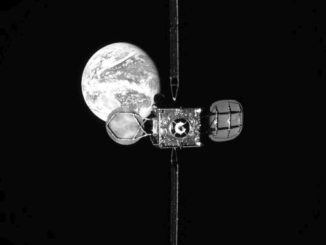
The National Reconnaissance Office has confirmed it will launch a payload on a SpaceX Falcon 9 rocket from Cape Canaveral later this month, a mission on SpaceX’s schedule that was not publicly disclosed until recently.
A regulatory filing with the Federal Communications Commission recently revealed plans for a SpaceX launch from Cape Canaveral scheduled for Oct. 25. But details of the mission in the filing did not match any known launch on SpaceX’s schedule, raising speculation that the launch might carry a national security payload for the U.S. government.
SpaceX has launched national security missions before that went unannounced until the final stages of launch preparations. The Zuma mission, a mysterious payload launched for the U.S. government in January 2018, was not publicly listed in any launch schedules or contract announcements until the final weeks before its planned liftoff.
In response to a question from Spaceflight Now, an NRO spokesperson confirmed Monday that it is the customer for the Falcon 9 launch scheduled no earlier than Oct. 25.
The NRO owns the U.S. government’s fleet of intelligence-gathering spy satellites, providing imagery, signals intelligence, and other data.
Following its typical policy for public disclosures, the NRO has not revealed any information about the payload on the Falcon 9 flight later this month. But the NRO and U.S. military officials typically disclose the existence of most NRO missions years ahead of time.
The Falcon 9 mission is designated NROL-108, and will launch from Cape Canaveral Air Force Station, the NRO spokesperson said.
The NRO said in 2018 that the Zuma mission, which failed soon after launch, did not belong to that agency. If that remains the case, it does not appear likely that the NROL-108 mission is a replacement for Zuma, despite the similarities in how the missions were disclosed to the public.
Information revealed in SpaceX’s FCC filing, which seeks authority operate radio transmitters for the mission, indicates the Falcon 9’s first stage booster will return to Cape Canaveral after liftoff for a touchdown at Landing Zone 1.
On many SpaceX launches, the Falcon 9 booster lands on a drone ship positioned several hundred miles offshore. The first stage does not need to reserve as much propellant for landing on the drone ship, but requires more fuel set aside to reverse course and return to an onshore landing near the launch site.
Plans for a booster landing back at Cape Canaveral for the NROL-108 mission suggest it is set to deploy its payload in a low-altitude orbit, or that the satellite (or satellites) on-board will be relatively light.
The NROL-108 launch is one of three missions for the National Reconnaissance Office that could blast off this month from Cape Canaveral.
A classified payload is awaiting liftoff on a United Launch Alliance Delta 4-Heavy from pad 37B at the Florida spaceport. That mission, codenamed NROL-44, was supposed to launch in late August, but has been grounded by a series of problems with launch pad equipment.
The most recent launch attempt Sept. 30 ended seven seconds before liftoff when an automatic countdown sequencer triggered an abort. ULA has not announced a new target launch date.
Meanwhile, ULA teams at pad 41 are preparing to launch an Atlas 5 rocket later this month with the NROL-101 mission, set to loft another classified NRO spy satellite.
Email the author.
Follow Stephen Clark on Twitter: @StephenClark1.



